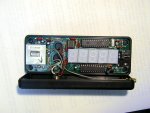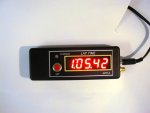First, my experience with Picaxe (or any microcontroller) is nill. I am absolutely brand new to this side of electronics. But I am a very curious person that likes to understand how things work and I like to design things myself, so this aught to prove interesting.
Second, what I am trying to do is create a display unit that will give me the current date (1st 4-digit display – MM D), the date in 1 week (2nd 4-digit display), the date in 2 weeks (3rd display) and the date in 4 weeks (4th display). At the base of the whole unit I want to have 5 buttons (1 for each work day).
D), the date in 1 week (2nd 4-digit display), the date in 2 weeks (3rd display) and the date in 4 weeks (4th display). At the base of the whole unit I want to have 5 buttons (1 for each work day).
At this point I am mainly concerned with the board layout/wiring. I am slightly (emphasis on that) confident that I could get the script part working. I have been reading a ton from this forum and many other sites and have not found any conclusive guidance on wiring my particular project.
Question 1: My first question is if anyone would be able to help me decide where and what size resistors to use on my board. Most of what I read says to put a 330k resistor (I think that's the size) between the LED and a microcontroller but I am not sure if that applies with these 7-segments (I assume it does) and at what rating I should use. **After finishing my schematic, which is attached, I noticed that there is no V+ on the LED displays. So then I take it power comes from the MAX7219s? If so, how to I limit the voltage down to the 3.4v and 2.1v that are allowed on the LEDs?**
My parts that I am planning to use are :
1 – Picaxe 40x2
2 – MAX7219’s
4 – 4-digit 7-segment displays from Sparkfun.com (com-09480, 81, 82, 83)
1 - Single digit Alphanumeric display
1 – Maxim DS1307 (for my current date)
1 – 32.768 khz crystal from Sparkfun.com (COM-00540)
I know my 4-digit displays are common anode and the MAX7219 is a common cathode but I have read many instances where I can reverse setup (connect display CA’s to MAX CC’s). I am also looking around to try and find a reasonably priced set of the displays in CC but have not had much luck since I want them in different colors. If you know of some, please let me know!
For my power I plan to use a DC wall jack, as it will be sitting on my desk. I know that my voltage ratings are varied among my parts because the blue led display uses 3.4V, the other three displays use around 2.1V, and the picaxe and MAX7219s can use 5v.
Question 2: Any suggestions on what voltage my DC should use (is there any benefit to going with a 9v or 12v verses my max 5.5v)? And can I just split off of this one DC supply to different voltage regulators?
I have attached a schematic from Eagle as a PDF to try to give a better idea of my project. If I left anything out let me know. At this point I am open to any wiring suggestions and advise.
View attachment work.pdf
Thank you beforehand to anyone that is able and willing to help!
Sean
Second, what I am trying to do is create a display unit that will give me the current date (1st 4-digit display – MM
At this point I am mainly concerned with the board layout/wiring. I am slightly (emphasis on that) confident that I could get the script part working. I have been reading a ton from this forum and many other sites and have not found any conclusive guidance on wiring my particular project.
Question 1: My first question is if anyone would be able to help me decide where and what size resistors to use on my board. Most of what I read says to put a 330k resistor (I think that's the size) between the LED and a microcontroller but I am not sure if that applies with these 7-segments (I assume it does) and at what rating I should use. **After finishing my schematic, which is attached, I noticed that there is no V+ on the LED displays. So then I take it power comes from the MAX7219s? If so, how to I limit the voltage down to the 3.4v and 2.1v that are allowed on the LEDs?**
My parts that I am planning to use are :
1 – Picaxe 40x2
2 – MAX7219’s
4 – 4-digit 7-segment displays from Sparkfun.com (com-09480, 81, 82, 83)
1 - Single digit Alphanumeric display
1 – Maxim DS1307 (for my current date)
1 – 32.768 khz crystal from Sparkfun.com (COM-00540)
I know my 4-digit displays are common anode and the MAX7219 is a common cathode but I have read many instances where I can reverse setup (connect display CA’s to MAX CC’s). I am also looking around to try and find a reasonably priced set of the displays in CC but have not had much luck since I want them in different colors. If you know of some, please let me know!
For my power I plan to use a DC wall jack, as it will be sitting on my desk. I know that my voltage ratings are varied among my parts because the blue led display uses 3.4V, the other three displays use around 2.1V, and the picaxe and MAX7219s can use 5v.
Question 2: Any suggestions on what voltage my DC should use (is there any benefit to going with a 9v or 12v verses my max 5.5v)? And can I just split off of this one DC supply to different voltage regulators?
I have attached a schematic from Eagle as a PDF to try to give a better idea of my project. If I left anything out let me know. At this point I am open to any wiring suggestions and advise.
View attachment work.pdf
Thank you beforehand to anyone that is able and willing to help!
Sean



